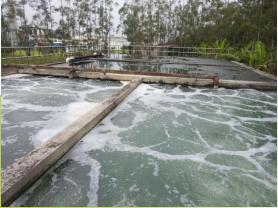Can deodorants treat water pollution?
Water quality purification is a phased management method for water management, and ecological correction is a long-term solution for maintaining water quality. Most of the water quality purification skills learn sewage treatment skills for water body correction, such as A2O, flocculation sedimentation, biological filters, artificial wetlands, ecological floating islands, stable ponds, etc., which have been used in practical engineering. However, there has not yet been a set of mature and feasible detailed skill routes for water quality purification of black and odorous water bodies, which is also a problem encountered in the current management process of black and odorous water bodies.
The management of black and odorous water pollution is a difficult point in the water pollution management industry. Overall, the management of black and odorous water pollution is a long-term mission. There are many causes and conditions of water pollution, and it is difficult to control. In addition, there is no set of mature and useful skills, so the effectiveness is not very significant. Together, the management of black and odorous water pollution involves multiple departments, with huge construction and operation costs, minimal economic returns, and a tendency to decrease productivity, which can lead to heavy construction, light operation, and rebound of black and odorous water bodies.
Source control, pollution interception, and endogenous management are the foundation and conditions for the management of black and odorous water bodies. Source control and pollution interception mainly rely on the construction and renovation of sewage pipelines along the water body to intercept and treat sewage into the sewage collection and treatment system. Perhaps through non-point source pollution control skills, direct discharge of pollutants into the water body can be reduced from the source, which is also the key and difficult point of black and odorous water management. Most of the internal management skills nowadays rely on manual/mechanical dredging methods to eliminate pollution.
The Water Pollution Management Committee reviewed the management policies and their completion status, as well as the development status of management skills, in the five categories of black and odorous water pollution management, rural sewage management, sludge treatment, upgrading and renovation of township sewage treatment plants, and sewage management in industrial clusters.

Deodorants are products extracted from pure plants that integrate air purification, deodorization, antibacterial properties, and external cleaning. Bacteria breed and produce a lot of harmful odorous gases such as ammonia, hydrogen sulfide, amines, aromatics, alcohols, organic acids, indoles, etc. They can effectively decompose any odors produced by organic matter fermentation, achieving the function of cleaning and purifying the air. It has the characteristics of non irritating air antibacterial properties. This product can also accelerate the rapid decomposition of organic matter and reduce its volume. The long-term effect will become more significant.
Active water circulation and clear water replenishment mainly rely on methods such as urban recycled water and clean surface water as compensation sources for managing water bodies, to increase water mobility. This type of treatment skill has a significant effect, but it requires setting up pumping stations, laying pipelines, etc., which is difficult to construct and operate. In the process of water diversion, it is necessary to avoid introducing new sources of pollution.
The management of black and odorous water pollution should be based on the actual situation of each black and odorous water body, and feasible and economically reasonable skills should be selected and implemented in detail according to the causes of pollution and management policies. It is not advisable to use a unified standard to select skills, but should focus on "one water, one plan". In addition, in order to ensure the systematic and useful management of black and odorous water pollution, it is necessary to comprehensively consider the surrounding sewage treatment plants, water supply and drainage networks, watershed water environment, and other aspects, and coordinate the management of urban water environment, adhering to the long-term qualified water quality.
The article originates from a deodorant manufacturer http://www.scneng.com.hk
-
06-11
"Environmental Doctor" Du Siyuan: Environmental Protection is a Lifestyle Attitude
There is a Hong Kong compatriot in Jiangmen who often frequents various farms and plantations, walks in mechanical factories, and is seen by others as the nemesis of environmental problems. He conside
-
03-16
Deodorant manufacturer: Deodorants reduce soil pollution
Waste is a chaotic mixture of various components. The accumulation of debris on the surface of soil can cause some chemical reactions, releasing harmful gases, which can lead to soil pollution and eve
-
12-01
Deodorant Manufacturers: Differences between Microbial Deodorants and Traditional Deodorants
The waste that is not needed in our daily life and work is called waste. Due to the large amount of waste discharged and the complex categories, there are great difficulties in reducing waste and deod
-
11-08
Application of Deodorant Manufacturers in Domestic Waste Treatment
Garbage is the waste generated in everyone's daily life and work. Due to its large discharge volume and complex and diverse composition, it poses great difficulties in reducing and deodorizing wa
